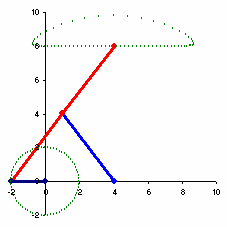Mechanical Power Transmission using Belt Drives and Chain Drives
Major types of flexible mechanical power transmission are belts and chains. Belts operate on pulleys or sheaves, whereas chains operate on toothed wheels called sprockets.
When to use chain drives or belt drives?
Electric motors typically operate at too high speed e.g. 1500 rpm and deliver too low torque e.g. 1.8 N.m to be appropriate for the final drive application. These figures are taken from 0.25 kW motor specs of some manufacturers just to get an idea. For a given power transmission, the torque is increased in proportion to the amount that rotational speed is reduced. So the method of speed reduction is usually required for normal mechanical power transmission system.
Usually, we use belt drives for first stage reduction because of high speed of the motor. A smaller drive pulley is attached to the motor shaft which runs at high speed, while a larger diameter pulley is attached to the parallel shaft that operates at a correspondingly lower speed.
However, the output of gear reducers must often be reduced more before meeting the requirements of the machine because the gear reducers are available only at discrete reduction ratios. At the low-speed, high-torque condition, chain drives become desirable. The high torque causes high tensile force in the chain. The chains normally made of metal and they can withstand the high forces.
When to use chain drives or belt drives?
Electric motors typically operate at too high speed e.g. 1500 rpm and deliver too low torque e.g. 1.8 N.m to be appropriate for the final drive application. These figures are taken from 0.25 kW motor specs of some manufacturers just to get an idea. For a given power transmission, the torque is increased in proportion to the amount that rotational speed is reduced. So the method of speed reduction is usually required for normal mechanical power transmission system.
Usually, we use belt drives for first stage reduction because of high speed of the motor. A smaller drive pulley is attached to the motor shaft which runs at high speed, while a larger diameter pulley is attached to the parallel shaft that operates at a correspondingly lower speed.
" Usually, we use belt drives for first stage reduction because of high speed of the motor..."However, we can imagine that for the very large ratios of speed reduction, gear reducers are desirable because they can typically accomplish large reductions in a rather small package. The output shaft of the gear-type speed reducer is generally at low speed and high torque. If both speed and torque are satisfactory for the application, it could be directly coupled to the driven machine.
However, the output of gear reducers must often be reduced more before meeting the requirements of the machine because the gear reducers are available only at discrete reduction ratios. At the low-speed, high-torque condition, chain drives become desirable. The high torque causes high tensile force in the chain. The chains normally made of metal and they can withstand the high forces.
" At the low-speed, high-torque condition, chain drives become desirable..."In general, belt drives are used where the rotational speeds are relatively high, which results in relatively low tensile forces in the belt. But at lower speed, the tensile force in the belt becomes too large for typical belt cross sections and may lead to slipping between sides of the belt and pulleys (or sheaves)




Comments